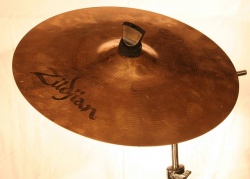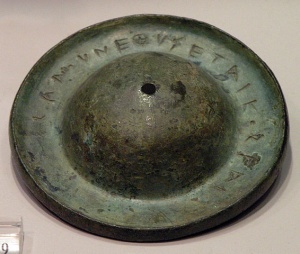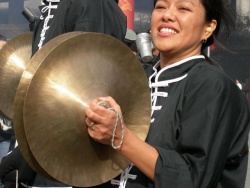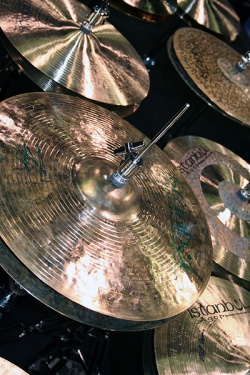Cymbal
Cymbals are a common percussion instrument. Cymbals consist of thin, normally round plates of various alloys; see cymbal making for a discussion of their manufacture. The majority of cymbals are of indefinite pitch, although small disc-shaped cymbals based on ancient designs sound a definite note (see: crotales). Cymbals are used in many ensembles ranging from the orchestra, percussion ensembles, jazz bands, heavy metal bands, and marching groups. Drum kits usually incorporate at least a crash, ride or crash/ride, and a pair of hi-hat cymbals.
Etymology

The word cymbal is derived from the Latin cymbalum, which is the latinisation of the Greek word κύμβαλον (kumbalon), "cymbal", which in turn derives from κύμβος (kumbos), "cup".
Anatomy
The anatomy of the cymbal plays a large part in the sound it creates. The hole is drilled in the center of the cymbal and it is used to either mount the cymbal on a stand or straps (for hand playing). The bell, dome, or cup is the raised section immediately surrounding the hole. The bell produces a higher "pinging" pitch than the rest of the cymbal. The bow is the rest of the surface surrounding the bell. The bow is sometimes described in two areas: the ride and crash area. The ride area is the thicker section closer to the bell while the crash area is the thinner tapering section near the edge. The edge or rim is the immediate circumference of the cymbal.
Cymbals are measured by their diameter often in inches or centimeters. The size of the cymbal affects its sound, larger cymbals usually being louder and having longer sustain. The weight describes how thick the cymbal is. Cymbal weights are important to the sound they produce and how they play. Heavier cymbals have a louder volume, more cut, and better stick articulation (when using drum sticks). Thin cymbals have a fuller sound, lower pitch, and faster response.
The profile of the cymbal is the vertical distance of the bow from the bottom of the bell to the cymbal edge (higher profile cymbals are more bowl shaped). The profile affects the pitch of the cymbal: higher profile cymbals have higher pitch.
Types
Orchestral cymbals
Cymbals offer a composer nearly endless amounts of color and effect. Their unique timbre allows them to project even against a full orchestra and through the heaviest of orchestrations and enhance articulation and nearly any dynamic. Cymbals have been utilized historically to suggest frenzy, fury or bacchanalian revels, as seen in the Venus music in Wagner's Tannhäuser, Grieg's Peer Gynt suite, and Osmin's aria "O wie will ich triumphieren" from Mozart's Die Entführung aus dem Serail.
Clash cymbals
Orchestral clash cymbals are traditionally used in pairs, each one having a strap set in the bell of the cymbal by which they are held. Such a pair is also known as crash cymbals or plates.
The sound can be obtained by rubbing their edges together in a sliding movement for a "sizzle", striking them against each other in what is called a "clash", tapping the edge of one against the body of the other in what is called a "tap-clash", scraping the edge of one from the inside of the bell to the edge for a "scrape" or "zischen," or shutting the cymbals together and choking the sound in what is called a "hi-hat chick" or crush. A skilled player can obtain an enormous dynamic range from such a pair of cymbals. For example, in Beethoven's ninth symphony, the percussionist is employed to first play cymbals at pianissimo, adding a touch of colour rather than loud clash.
Clash cymbals are usually damped by pressing them against the player's body. A composer may write laissez vibrer, "Let vibrate" (usually abbreviated l.v.), secco (dry), or equivalent indications on the score; more usually, the player must judge exactly when to damp the cymbals based on the written duration of clash and the context in which it occurs.
Clash cymbals have traditionally been accompanied by the bass drum playing an identical part. This combination, played loudly, is an effective way to accentuate a note since the two instruments together contribute to both very low and very high frequency ranges and provide a satisfying "clash-bang-wallop". In older music the composer sometimes provided just one part for this pair of instruments, writing senza piatti or piatti soli (Italian: "without cymbals" or "cymbals only") if the bass drum is to remain silent. This came from the common practice of only having one percussionist play both instruments, using one cymbal mounted to the shell of the bass drum itself. The player would clash the cymbals with his left hand and use a mallet to strike the bass drum in his right. This method is often employed today in pit orchestras and is called for specifically by composers who desire a certain effect. Stravinsky calls for this in his ballet Petrushka and Mahler calls for this in his Titan Symphony.
The modern convention is for the instruments to have independent parts. However in kit drumming, a cymbal crash is still most often accompanied by a simultaneous kick to the bass drum, which provides both a musical effect and a support to the crash stroke.
Hi hats
Crash cymbals evolved into the low-sock and from this to the modern hi-hat. Even in a modern drum kit, they remain paired with the bass drum as the two instruments which are played with the player's feet. However, hi-hat cymbals tend to be heavy with little taper, more similar to a ride cymbal than to a clash cymbal as found in a drum kit, and perform a ride rather than a clash function.
Suspended cymbal
Another use of cymbals is the suspended cymbal. This instrument takes its name from the traditional method of suspending the cymbal by means of a leather strap or rope, thus allowing the cymbal to vibrate as freely as possible for maximum musical effect. Early jazz drumming pioneers borrowed this style of cymbal mounting during the early 1900s and later drummers further developed this instrument into the mounted horizontal or nearly horizontally mounted "crash" cymbals of a modern drum kit, However, most modern drum kits do not employ a leather strap suspension system. Many modern drum kits use a mount with felt or otherwise dampening fabric to act as a barrier to hold the cymbals between metal clamps: thus forming the modern day ride cymbal.
Suspended cymbals can be played with yarn, sponge or cord wrapped mallets. The first known instance of using a sponge-headed mallet on a cymbal is the final chord of Hector Berlioz' Symphonie Fantastique. Composers sometimes specifically request other types of mallets like felt mallets or timpani beaters for different attack and sustain qualities.
Suspended cymbals can produce bright and slicing tones when forcefully struck, and give an eerie transparent "windy" sound when played quietly. A tremolo, or roll (played with two mallets alternately striking on opposing sides of the cymbal) can build in volume from almost inaudible to an overwhelming climax in a satisfyingly smooth manner (as in Humperdink's Mother Goose Suite).
The edge of a suspended cymbal may be hit with shoulder of a drum stick to obtain a sound somewhat akin to that of a pair of clash cymbals. Other methods of playing include scraping a coin or a triangle beater rapidly across the ridges on the top of the cymbal, giving a "zing" sound (as some players do in the fourth movement of Dvořák's Symphony No. 9). Other effects that can be used include drawing a cello or bass bow across the edge of the cymbal for a sound not unlike squealing car brakes.
Ancient cymbals
Ancient cymbals or tuned cymbals are much more rarely called for. Their timbre is entirely different, more like that of small hand-bells or of the notes of the keyed harmonica. They are not struck full against each other, but by one of their edges, and the note given in by them is higher in proportion as they are thicker and smaller. Berlioz's Romeo and Juliet calls for two pairs of cymbals, modelled on some old Pompeian instruments no larger than the hand (some are no larger than a crown piece), and tuned to F and B flat. The modern instruments descended from this line are the crotales.
List of cymbal types
Cymbal types include:
- Bell cymbal
- China cymbal
- Clash cymbal
- Crash cymbal
- Crash/ride cymbal
- Hi-hat
- Ride cymbal
- Sizzle cymbal
- Splash cymbal
- Swish cymbal
- Finger cymbal
- Taal or Manjira (clash cymbal)




